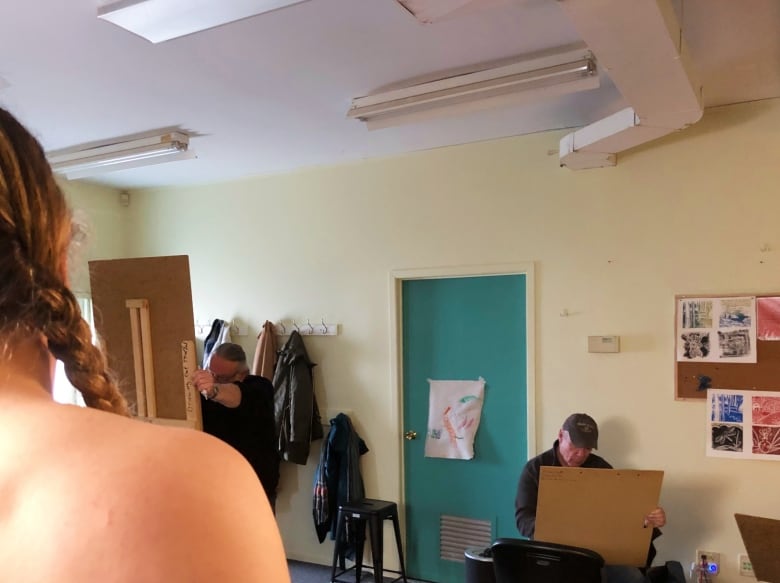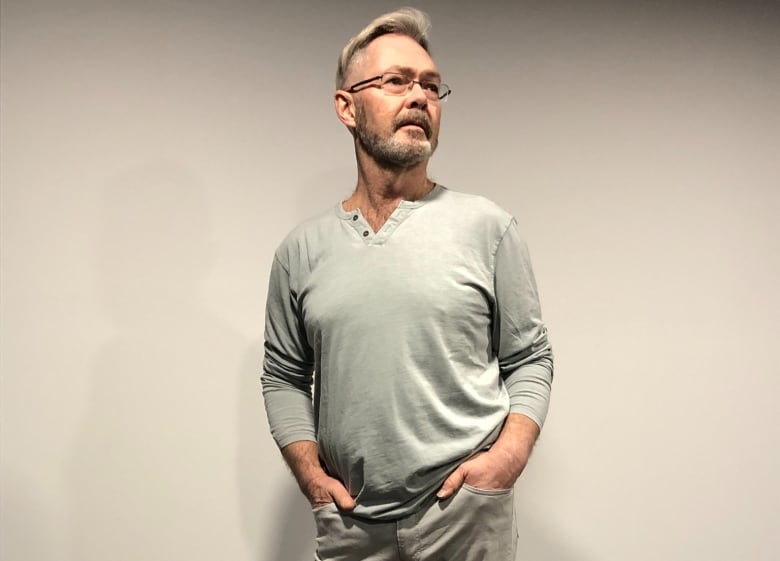Michelangelo’s David, Da Vinci’s Vitruvian Man, and Botticelli’s The Birth of Venus are some of the most recognizable artworks of all time — and they all have one thing in common.
Nudity.
While it may elicit giggles from some, the naked human body has a more than 35,000-year-long history in art.
Its form, muscles and movement are something great artists have studied for generations, and some are still doing so here on P.E.I.
“I still have butterflies in my belly every time I undo the knot in my robe,” says Wayne Crouse, a longtime life drawing model. “Because you’re really putting yourself 100 per cent on display,”
Island Morning7:20Artists find inspiration, kinship while practising drawing the human form
Every Sunday, a group of artists gathers in Stratford for a unique experience — to draw or paint a live nude model in a variety of poses. Victoria Walton spoke with artists and models about what they gain from the experience.
Each Sunday, about a dozen artists gather at the Gertrude Cotton Centre in Stratford. They set up their easels, pull out their pencils or paints, and focus their attention on the live model in the middle of the room.
Then the model takes off their robe.
“The biggest challenge is to actually be centre stage in a room where you’re the only one just wearing a smile,” says Crouse.
‘Hey, I could do that’
The life drawing meetups have been going on for more than two decades, and have been at their current Bunbury Road location for the past 10 years. Artists attending each session contribute $10 to pay the models.
Modelling for Island artists is something Crouse stumbled into by chance almost 20 years ago. He recalls needing some extra cash, and seeing an ad in the paper that the Confederation Centre was offering a two-day life drawing workshop.
“And I thought, ‘Hey, I could do that,'” he recalls. But when asked if it’s as easy as he thought it would be, Crouse laughs, “Hell no!”
He said the hardest part is holding a single pose for between 20 and 40 minutes.
“Our legs go to sleep, our arms go to sleep, we lose circulation,” he explains. “It can be very painful.”
But Crouse says over time, he’s learned what his body is — and isn’t — capable of.
“You go with your strengths, and you say goodbye to your weaknesses,” he says.
Raw beauty
For the artists who attend the sessions regularly, it’s not just about the anatomy of the nude models — but more about the observing and capturing their lines, shadows and curves.
“Yes, it’s a naked body, but that’s not the focus,” says Cornwall resident Hank Bos, who has been doing life drawing for more than three decades. “The focus is on drawing those shapes.”
Bos usually works with pen on paper. And although the resulting artwork is rarely perfect, he said that’s part of the beauty of the practice.

“I love the mistakes and I rework them and I just enjoy the mistakes,” he says. “Mistakes are wonderful.
“That’s how you learn, that’s how you grow.”
Coming to the life drawing sessions energizes Bos to do other artwork, he says. And although it’s not an instructional class, he says he still learns a lot from the other artists who show up.
“It’s almost a meditative experience,” he says. “Because there’s usually beautiful music in the background.
“No one talks to anybody. We just draw and focus. There’s nothing like it.”
Meeting other artists
Many of the artists didn’t start life drawing in Stratford, however.
For Gary Schoenfeldt, who’s also on the program’s organizing committee, he started life drawing when he lived in Saskatchewan. So he was pleasantly surprised to find a meetup nearby when he moved to Stratford.
“I like being able to have a community group like this to come and do that type of thing,” he says. “I didn’t know any other artists when I moved here, and now I know all kinds of artists.”
The artists in the group don’t shy away from drawing the person exactly as they are. Curves, scars and body hair make appearances in their artwork. But it’s not meant to be scandalous — it’s simply practicing a skill.
“This is the kind of art that’s been around as long as there’s been art,” Schoenfeldt says. “You can go into the Sistine Chapel and look at Michelangelo’s stuff on the ceiling.
“That guy couldn’t do anything like that without life drawing — no one can. It’s the basis of all art, really.”

For Stratford artist Chris Mollins, life drawing is much different from his usual acrylic on canvas work. But it allows him to study the human form.
“In order to be able to incorporate people into my artwork, you really have to understand how all the muscles are intertwined [and] understand bone structure as well,” he says.
Animator Katelynn Hicks says she was nervous to attend at first. Now she looks past the nudity, and focuses on the depth of her drawings.
“You get used to the fact, and just the general beauty of the person in front of you and all their shapes and … interesting features,” she says. “So you ignore the fact that, hey, they don’t have any clothes on.”

Accepting your flaws
Crouse started life drawing modelling when he was about 40 years old. After recently turning 60, he calls himself one of the “older models” who pose for the group.
But with that nearly 20 years’ experience comes wisdom — and acceptance of his own body.
“We all have characteristics that we’re not happy about, our own personal flaws,” he says. “But I quickly realized artists are looking at light and shadow lines, form and movement.
“And I also came to the realization we all come in different shapes, different forms.”
Crouse says he doesn’t get recognized much with his clothes on. But every now and then an artist will tell him they’ve had his image framed and hung on the wall.
In the past, he used to dislike that. Now, he takes such remarks as a compliment.
“I didn’t like seeing my body on paper when I wasn’t the healthiest version that I could be,” he says. “It wasn’t a vanity thing, but it was a kick in the pants to get myself on a much better track.
“Now I’m 60, probably in the best shape of my life.”






